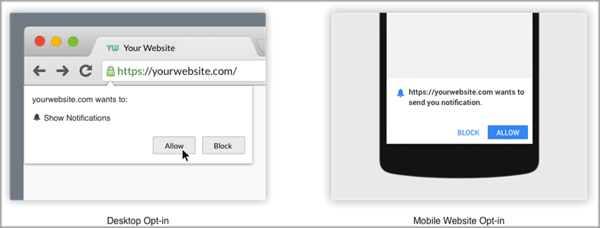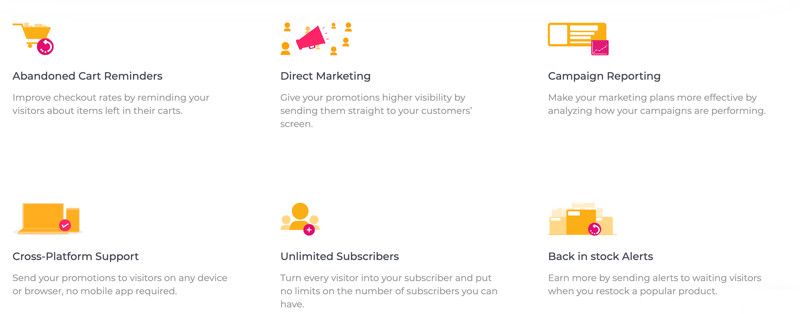Web push is a relatively new but fast-growing tool to deliver direct messages right to users’ desktop or mobile phone. It should not be ignored but be included in your marketing strategy to increase the conversion rates across a variety of industries.
What is Web Push Notification Marketing?
A web push notification is a message sent to a device (mobile, tablet, laptop) by a browser. It is an effective communication channel that marketers can leverage to inform their target audience about services, products, promotions and other updates.
Like other marketing channels, a push message can only be sent to those who consent to receive notifications. The opt-in usually occurs when people visit a website with a pop up asking if they would like to receive updates from the website. If a user clicks the ‘allow’ button they will automatically be subscribed to receive these updates.

Desktop and mobile website push notification opt-in message
Why You Cannot Ignore Web Push Notification?
Web Push Notification should be treated as a part of an ongoing SEO & marketing strategy, as it has a lot of advantages over other channels.
- You don't need to know a person's contact info to build a relationship with them:
- It has a much higher clickthrough rate:
- It allows you to re-engage the traffic on another channel:
- Adjust the best frequency and timing for push notifications
- Send relevant, value-added information to your subscribers
Not all people who browse your website take action to leave their contact details through online purchases, contact forms or subscribing to your emails. Push notifications actually reduces the friction in subscribing as there is no need for the user to provide any personal information, which does not demand too much from the ‘subscriber’. The opt-in action needed is simply to click the ‘allow’ button so that you can keep your users engaged with new updates that are relevant to them. The opt-in rates for push notifications are generally much higher than email subscriptions.

Web push notification example from Google Blog showing latest updates
Best practice, when asking for consent, is to explain the benefits of receiving your push notifications, and what kind of content they can expect to receive from you.
According to Campaign Monitor the average click-through rates on email is between 1-5% with 2.5% as the benchmark. Marketers often struggle with the email spam filter or Google’s promotion tab, which impacts successful email delivery. For push notification, there is no such thing. Your message will go directly to the user rather than getting hung up in a spam folder. According to Subscriber, one of the software companies providing the push notification solution, the average click-through rate is anywhere between 4-16% which is much higher than the email marketing click-through rate. However, you still need to ensure you don’t spam your audience by delivering value-added information to them with a calculated frequency.
It is a low-cost way to build mindshare with your target audience, even if they don’t click on every push you send. Since the click-through rates are high on web push notifications, once a user comes to your site, the conversion rate of that traffic will be very high as well. A web push message is an effective remarketing channel to allow you to further engage or nurture your visitors who do not convert when they first visit your website.
Best practices for Push Notification Marketing:
Though it has the above-mentioned advantages over email marketing, web push does not replace email, rather it compliments it. Push notification messages should be treated as another marketing channel that you can leverage, which you need to have a strategy for just like any other marketing channel. Here are some best practices for when you start planning your web push marketing strategy:
The right timing and frequency are critical for push notifications. Overwhelming visitors with a high frequency or sending at the wrong time can come across as spam. When scheduling the perfect time, take into consideration: users’ time zones, their preferred time of day to browse your website and from your analytics, the day and time you tend to get the highest conversion rate.
Additionally, always pay attention to the opt-out rate. A high opt-out rate might indicate that your frequency of push notifications is too high.
For eCommerce websites, you can use web push to send transactional alerts such as delivery notifications, or alerts to remind customers of their abandoned cart. The key is to use personalization to provide content that is useful and relevant to your target audience.
You can also broadcast your new updates like a new blog post, new eBook, new product or service launch to bring subscribers back to your site to stay informed. Another popular use of web push notifications is to share special offers or incentives. This can sometimes include coupons, discounts or other special offers that encourage conversions and gives visitors a compelling reason to come back to your website.

Examples of how we can use push notification to achieve (image from pushowl)
Conclusion
Web push is a relatively new but fast-growing tool to deliver direct messages right to a users’ desktop or mobile phone. It should not be ignored but be included in your marketing strategy. Like any marketing channel, you need to test, analyze and optimize. You can target pushes and you can use browser pushes to increase your conversion rates across a variety of industries.
There are a lot of tools available that you can use to start your web push notification marketing which offer seamlessly integrate with your Shopify eCommerce or Hubspot CRM. The installation and set up are very simple and provides end-to-end tracking which allows you to test, monitor and optimize your push marketing channel to achieve the best performance.
